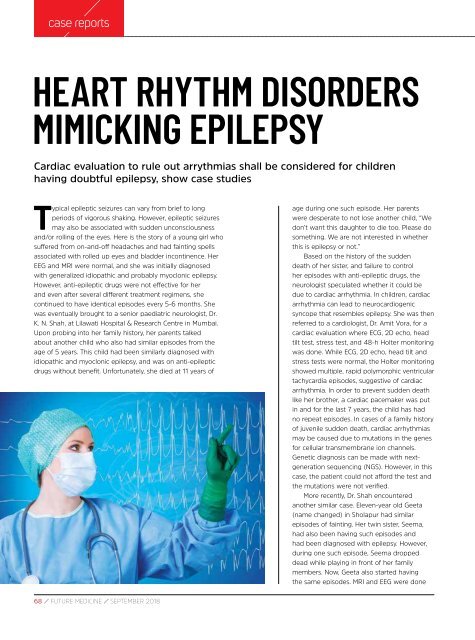FM SEPTEMBER 2018 ISSUE - digital edition
Create successful ePaper yourself
Turn your PDF publications into a flip-book with our unique Google optimized e-Paper software.
case reports<br />
HEART RHYTHM DISORDERS<br />
MIMICKING EPILEPSY<br />
Cardiac evaluation to rule out arrythmias shall be considered for children<br />
having doubtful epilepsy, show case studies<br />
Typical epileptic seizures can vary from brief to long<br />
periods of vigorous shaking. However, epileptic seizures<br />
may also be associated with sudden unconsciousness<br />
and/or rolling of the eyes. Here is the story of a young girl who<br />
suffered from on-and-off headaches and had fainting spells<br />
associated with rolled up eyes and bladder incontinence. Her<br />
EEG and MRI were normal, and she was initially diagnosed<br />
with generalized idiopathic and probably myoclonic epilepsy.<br />
However, anti-epileptic drugs were not effective for her<br />
and even after several different treatment regimens, she<br />
continued to have identical episodes every 5-6 months. She<br />
was eventually brought to a senior paediatric neurologist, Dr.<br />
K. N. Shah, at Lilawati Hospital & Research Centre in Mumbai.<br />
Upon probing into her family history, her parents talked<br />
about another child who also had similar episodes from the<br />
age of 5 years. This child had been similarly diagnosed with<br />
idiopathic and myoclonic epilepsy, and was on anti-epileptic<br />
drugs without benefit. Unfortunately, she died at 11 years of<br />
age during one such episode. Her parents<br />
were desperate to not lose another child, “We<br />
don’t want this daughter to die too. Please do<br />
something. We are not interested in whether<br />
this is epilepsy or not.”<br />
Based on the history of the sudden<br />
death of her sister, and failure to control<br />
her episodes with anti-epileptic drugs, the<br />
neurologist speculated whether it could be<br />
due to cardiac arrhythmia. In children, cardiac<br />
arrhythmia can lead to neurocardiogenic<br />
syncope that resembles epilepsy. She was then<br />
referred to a cardiologist, Dr. Amit Vora, for a<br />
cardiac evaluation where ECG, 2D echo, head<br />
tilt test, stress test, and 48-h Holter monitoring<br />
was done. While ECG, 2D echo, head tilt and<br />
stress tests were normal, the Holter monitoring<br />
showed multiple, rapid polymorphic ventricular<br />
tachycardia episodes, suggestive of cardiac<br />
arrhythmia. In order to prevent sudden death<br />
like her brother, a cardiac pacemaker was put<br />
in and for the last 7 years, the child has had<br />
no repeat episodes. In cases of a family history<br />
of juvenile sudden death, cardiac arrhythmias<br />
may be caused due to mutations in the genes<br />
for cellular transmembrane ion channels.<br />
Genetic diagnosis can be made with nextgeneration<br />
sequencing (NGS). However, in this<br />
case, the patient could not afford the test and<br />
the mutations were not verified.<br />
More recently, Dr. Shah encountered<br />
another similar case. Eleven-year old Geeta<br />
(name changed) in Sholapur had similar<br />
episodes of fainting. Her twin sister, Seema,<br />
had also been having such episodes and<br />
had been diagnosed with epilepsy. However,<br />
during one such episode, Seema dropped<br />
dead while playing in front of her family<br />
members. Now, Geeta also started having<br />
the same episodes. MRI and EEG were done<br />
68 / FUTURE MEDICINE / <strong>SEPTEMBER</strong> <strong>2018</strong>


















